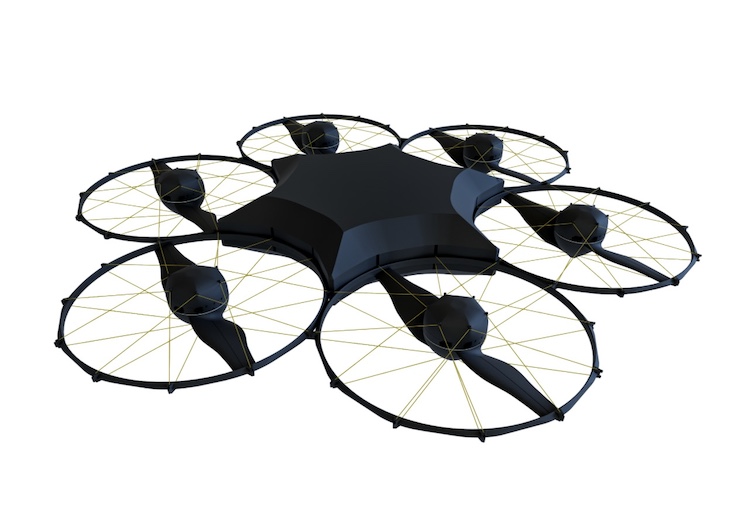
Nothing is more frustrating to drone operators and their clients than the limited battery power of drones. A typical UAV lasts no more than 15-18 minutes airborne before needing to return home to reboot. Some drones might feature mid-flight recharging capability but their flight endurance for infrastructure inspections or long distance cargo delivery remains limited.
With more BVLOS regulatory waivers available than ever before, it’s essential for drone operators to find new ways to bolster their onboard battery power.
Three year old Modovolo, based in upstate New York, thinks it has the answer: an extremely lightweight quadcopter that resembles four adjacent bicycle rims with a giant propeller at the center. The drone can fly continuously for two hours and can accommodate a wide range of payloads and missions – from aerial mapping and infrastructure inspections to accident scene reconstruction and search-and-rescue – giving it extraordinary versatility.
The cost of the Modovolo “Lift” drone – just $6,000, about half the price of most standard UAVs currently on the market – makes for another compelling sales point. Many companies with wide-ranging cargo delivery needs – or large properties to map – are looking to scale their operations. The costs of a drone fleet quickly pile up. The Lift’s modular design allows for more rims and propellers to be added, virtually at will, to accommodate expanded missions, with reduced marginal cost.
“The Quad-configured Modovolo Lift is priced at 50% less than a DJI Matrice 300 but has more payload capacity and at least twice the flight time,” Justin Call, one of the firm’s two co-founders boasts.
The propellers on the Lift are far larger than one finds on a standard UAV – about 27” in diameter. That gives the aircraft its extraordinary lift and allows it to accommodate heavier payloads, including sensors, cameras, and cargo. But unlike UAVs constructed from carbon fiber, the Lift relies for the most part on light metal and plastic. That keeps the weight of the standard quadcopter to just 8 pounds.
How will the new Lift drone perform in the field? Call and his co-founder are still testing the first prototype, so its presumed benefits aren’t yet fully validated. But the company is already building a full-scale manufacturing facility and offering advance purchasers of the first 200 drones a guaranteed priority. As a further enticement, Call says these initial purchasers will be permitted to advise on the production process to ensure that their drone closely matches their needs.
Call admits that the Lift, as currently conceived, may not be specialized enough to accommodate advanced agricultural seeding and pesticide operations. But one local company, Syracuse-based DropCopter, which has experimented with drones in the past for aerial pollination of its orchards, is already working closely with Modovolo on a custom-built design, with appropriate payload attachments.
“We are very interested in what [Modvolo] is working on. It would significantly help us scale and be able to treat many, many more acres per day,” says Matt Koball, DropCopter’s founder and CEO.
Modovolo’s upstate New York location is another key selling point. Other more established drone companies have introduced new – and expensive – precision agriculture drones. Koball says he and other local farmers skittish about cost and potential maintenance issues would prefer to work with a trusted user-friendly supplier.
For example, the latest DJI drones – including the recently released state-of-the-art T30 and T45 models – are far too expensive to purchase at scale, he notes. And they would also require farmers to become qualified to fly them, which under current FAA Part 137 certificate rules, is not so easy to accomplish, Koball says.
One option, according to Koball, is to let an FAA-qualified company like Modovolo fly and manage his new Lift drones. DropCopter will simply lease the company’s services, an arrangement that is allowed under current FAA rules.
Other local companies looking forward to working with Modovolo include M3 Technologies, which serves the tree fruit and nut industries, and Buffalo-based Eagle Hawk, a rapidly expanding building and infrastructure inspection company.
“Because of the new set of laws and regulations limiting the use of certain drones for government entities, we’ve been shut out of providing services for certain customers. The problem is that there are almost no options in the market that have the right capabilities at a price point that makes sense for us,” says Eagle Hawk CEO Patrick Walsh.
Call says Lift pre-orders are pouring in, and the company expects to be fully commercialized by the middle of 2025.
|